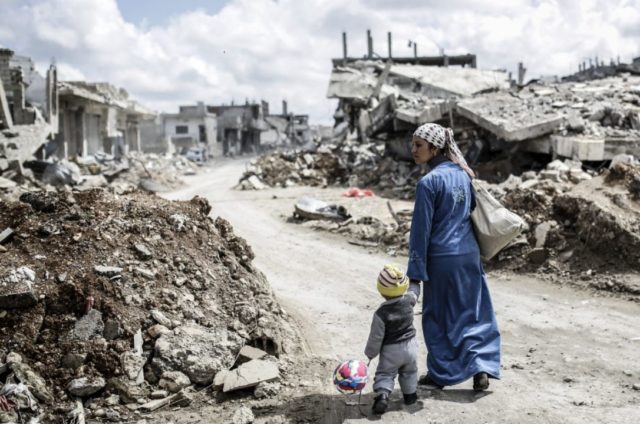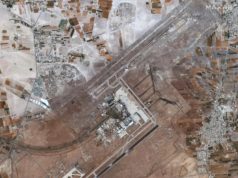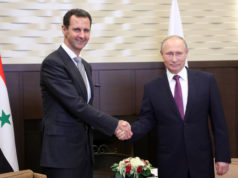“Never Again” was a rallying cry for Jews after the Holocaust. Never again would Jews be defenseless – force-marched, starved, and gassed, waiting to be rescued by an indifferent world.
It worked out pretty much that way.
But what happens when the forced march, starving, and gas happen to someone else? And what happens, specifically, when the United States and Russia – World War II allies – stand around not only watching, but complicit or even culpable? What happens when it happens in Syria?
To begin with are starvation and gas. The Syrian military under the protection of Russian air cover has dropped weaponized chlorine on civilians in various Sunni areas of Syria.
Secretary of Defense James Mattis laid blame on both, saying, “Either Russia is incompetent or in cahoots with Assad.” Mattis said it would be “very unwise” for the Assad regime to use chemical weapons. Acknowledging there is “no evidence” of the use of Sarin gas – specifically banned by the Geneva Convention – “there’s an awful lot of reports about chlorine gas use or about symptoms that could be resulting from chlorine gas.”
And chlorine gas kills just as surely. Our troops are in Syria – not in the areas under chemical attack, but still in the region. If we don’t have evidence is it because we’d rather not find it? That would make Russia culpable and America complicit.
The UN called starvation in Syria a war crime as early as 2016.
Iran is not using cattle cars, but it is assuredly committed to forcible removal of the Sunni center of Syria and transferring Shiites in behind them. Article 49(1) of the Geneva Convention states: “Individual or mass forcible transfers, as well as deportations of protected persons from occupied territory to the territory of the Occupying Power or to that of any other country, occupied or not, are prohibited, regardless of their motive.”
The second prohibition in Article 49 of the Fourth Geneva Convention of 1949 is in Article 49(6): “The Occupying Power shall not deport or transfer parts of its own civilian population into the territory it occupies.”
During the trial of the United Nations International Criminal Tribunal for the Former Yugoslavia (‘ICTY’) in the case of Radovan Karadzic, the Bosnian Serb leader, the Tribunal wrote, “Deportation [‘across a de jure border’] and forcible transfer [‘within national boundaries’] are defined as: (i) the forced displacement of one or more persons by expulsion or other forms of coercion, (ii) from an area in which they are lawfully present, (iii) without grounds permitted under international law.”
Syria is part of the Shiite Crescent that goes from Iran, through Iraq, Syria and Lebanon, and out to the Mediterranean Sea. Syria is the weak link because, although the government is Alawite (heterodox Shiite), Shiites are only 11 percent of the population; Sunnis are more than 75 percent with most of the remainder being Druze and Christian (Kurds are an ethnic minority of differing religions). If Iran plans to stay in Syria, which appears to be the case – both because of the Crescent and as a base against Israel – it needs fewer Sunnis and more Shiites.
The main Alawite area is on the Western coast, the primary Sunni areas are Damascus, Homs and Hama. Kurds are in the north. Most of the destruction since 2011 has been in the “Sunni Center,” with less on the coast near Latakia where the Russians have a naval base safe within Assad’s home territory. You can see the damage in Homs and Hama and Aleppo. The Sunni suburbs of Damascus and Palestinian refugee camps near the capital have been under siege from the beginning. The Yarmoukcamp, formerly 150,000 people, is now 4,300; Khan Esheih, originally 20,000 people, is now less than 10,000. The current, vicious fighting in the Sunni suburb of Ghouta is led by Iranian-organized Shiite militias, undeterred by the UN demand to stop. The broad movement of people out of Sunni-dominated areas under the yoke of an Alawite government, supported by Shiite Iran and its Afghan and Pakistani militia members, is the very definition of “ethnic cleansing.”
Which raises the question of “forcible population transfers.” Clearly, the Syrians who have fled their homes were “forcibly” ousted – meeting one prohibition of the Geneva Convention – the other prohibition, replacing one population with another, is also important. Think religion, not ethnicity.
American sources put the number of Iranian-commanded Shiite militia members at more than 80,000; Israeli sources say there are 3,000 members of Iran’s IRGC commanding 9,000 Hizb’allah, and 10,000 “violent Shia militias recruited from across the Mideast, including Iraq, Afghanistan and Pakistan.” The rest are Syrian – presumably Shiite. Iran controls more troops inside Syria than the Assad government. The Iranians plan to stay; what about their mercenary armies? Where else would they go? Human Rights Watch (HRW) says Iran been dragooning Afghans and Pakistani refugees in Iran into the militias, and “offered financial incentives… to encourage them to join pro-Syrian government militias.” This is a violation of their refugee status.
So where would they “go back” to? Leaving them in Syria, commanded by Iranian officers, would leave a Shiite mass in a foreign place. If Iran decided to “reunite” them with their families, it would constitute a forcible transfer of population in the multi-tens of thousands.
Former foreign minister Ali Akbar Velayati has called for a long-term Iranian military presence in Syria and Iraq. “If Iran is not present, no country can be the standard-bearer and guarantor of stability in the region.”
Responding to its own security requirements, but also cognizant of the weight of history, the Israeli government has said Israel will not permit Iranian/Shiite entrenchment. The United States should join Israel in that determination – not because we need to determine whether Bashar Assad stays or goes, but to fulfill the promise embedded in “Never Again.”






